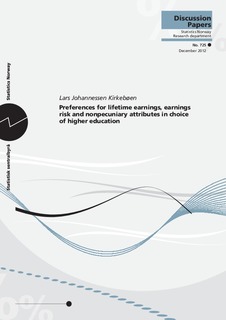| dc.contributor.author | Kirkebøen, Lars Johannessen | |
| dc.coverage.spatial | Norway | nb_NO |
| dc.date.accessioned | 2019-11-13T07:40:21Z | |
| dc.date.available | 2019-11-13T07:40:21Z | |
| dc.date.issued | 2012-12 | |
| dc.identifier.issn | 0809-733X | |
| dc.identifier.uri | http://hdl.handle.net/11250/2628020 | |
| dc.description.abstract | Expected earnings are considered to influence individuals' choice of education. However, the presence of nonpecuniary attributes and the different choice set available to prospective students make identification of this relationship difficult. This paper employs a conditional logit model on exceptionally rich application data, which are likely to reflect the actual preferences of the applicants, given their individual choice sets. Controlling for several nonpecuniary attributes, average lifetime earnings is shown to strongly influence educational choice. A one-percent earnings increase for a given education increases the number of male applicants by about 5 percent and female applicants by about 2 percent. However, other attributes also matter, in particular earnings risk. Increasing both earnings and risk as they correlate in the cross section has essentially no effect on the number of female applicants. Difference in earnings and risk preferences both contribute to a gender earnings differential. Finally, there is some preference heterogeneity by education chosen. | nb_NO |
| dc.language.iso | eng | nb_NO |
| dc.publisher | Statistisk sentralbyrå | nb_NO |
| dc.relation.ispartofseries | Discussion papers;725 | |
| dc.subject | JEL classification: J24 | nb_NO |
| dc.subject | JEL classification: J31 | nb_NO |
| dc.subject | JEL classification: C25 | nb_NO |
| dc.title | Preferences for lifetime earnings, earnings risk and nonpecuniary attributes in choice of higher education | nb_NO |
| dc.type | Working paper | nb_NO |
| dc.description.version | publishedVersion | nb_NO |
| dc.subject.nsi | VDP::Matematikk og Naturvitenskap: 400::Matematikk: 410::Statistikk: 412 | nb_NO |
| dc.source.pagenumber | 57 | nb_NO |
